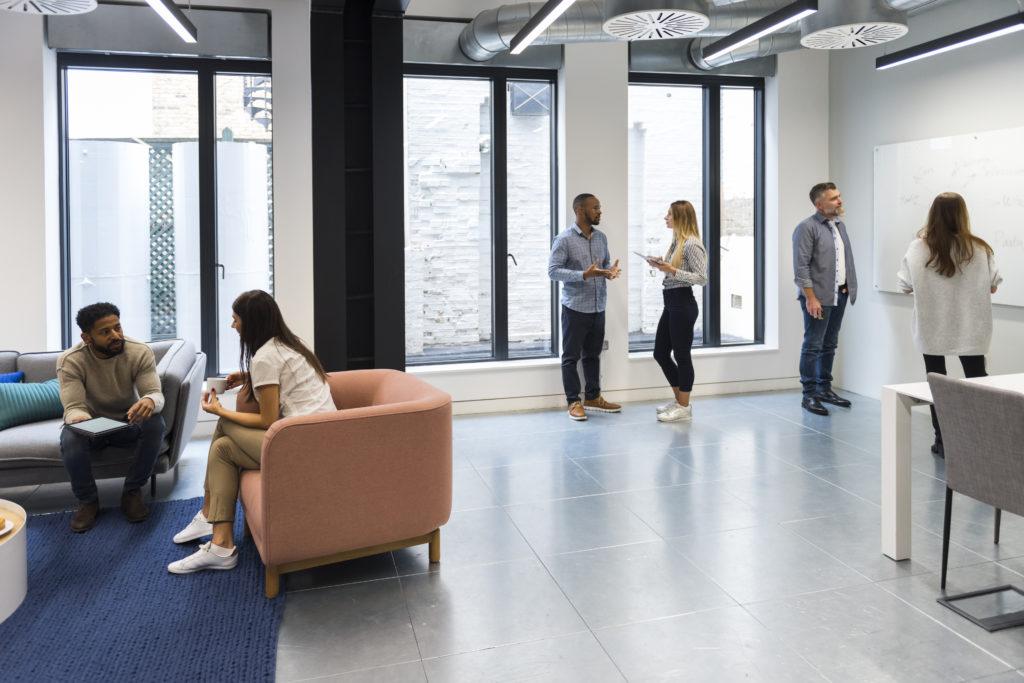Navigating Recruitment in Q4 2024
As we transition into autumn, the UK employment market continues to evolve. Here are the key trends observed by our senior recruitment specialists. Market Growth The UK economy has shown…
As wellbeing continues to dominate discussions in the workplace, attention is now being placed on the importance of where you physically work – the office environment in which you spend eight hours or more in every day and so office design is arguably one of the biggest contributors to overall employee wellbeing, affecting productivity and happiness.
2015 research by Steelcase revealed a direct correlation between employee engagement and a working environment1, with those happy with their overall surroundings stating they had a higher level of engagement.
For employers, a happier and more engaged workforce is generally more productive, which means a higher output and revenue. So just how can employers encourage office spaces that benefit their employees? Here are five things to consider.
Open-plan offices are a thing of the past. Despite over 8 million UK employees working in open-plan spaces2, numerous studies – the earliest dating back to 1997 – demonstrate that productivity significantly drops (up to 28%, as one report3 stated) and employees suffer mentally, physically and psychologically. What’s more, those working in open-plan environments are distracted or interrupted every three minutes, and take between eight and 20 minutes to get back into their flow. Therefore, it’s worth sitting down with a commercial design practice to see how you can create spaces that benefit employees, instead of working against them.
A consistent feature of ideally designed offices, break-out spaces are an immediate way to improve a working environment. They offer an opportunity for employees to break away from their desk, removing themselves from possibly stressful situations (or co-workers) and stepping away from a screen. When they return, they are more productive and focused on the task at hand. Break-out spaces can also inspire creativity, encourage spontaneous meetings and have been shown to help decrease employee stress levels and the feeling of being burnt out.

No-one would want their home to be devoid of natural light and proper ventilation – so why should the office be? A 2013 Northwestern University report found that there is a direct connection between exposure to daylight in workplaces and workers’ sleep and quality of life.4 Research by the World Green Building Council (WGBC) also revealed employees who sat next to windows had 46 minutes more sleep per night than those that didn’t, while workplaces with access to natural light had anywhere between a 3-40% gain in productivity and sales.5
Therefore, it’s vital employers choose a space that has multiple windows and that the resultant daylight is shared amongst all employees. Avoid blocking the light’s path with partitions or furniture and arrange desks so that they can take equal advantage of the window. The same WGBC report also found that air quality is equally as important to employee wellbeing, with productivity improving by 8-11%. While there are sometimes restrictions on offices in larger buildings, having windows that can at least lever out is ideal.
Along with light and air, plants complete what could be called trifecta of a healthy office environment. Having plants in the office can increase productivity by up to 15% and reduce tension by 37%, depression by 58%, hostility by 44% and fatigue by 38%6. In other words, they’re miracle workers. Pots placed strategically in the corners of offices operate both as a functional and decorative tool, brightening up even the most artificial of spaces.
Best of all, plants also clean the air of pollutants and carbon dioxide and absorb sounds, improving indoor air quality and reducing the noise pollution of the space.
Ariana Huffington is famous for scheduling meetings as a walk or hike, because she found some of her best ideas came from the simple act of walking. Her approach is just one of the many that sees traditional meeting rooms thrown to the side in favour of alternative options. The first significant change is understanding that designated meeting rooms don’t actually have to be rooms, but could be break-out spaces, coffee shops, restaurant tables or one of London’s fantastic parks. The change of location inspires creativity as it relaxes the participants and encourages a free flow of idea. After all, have you ever heard someone say “I have my best ideas at my desk or in a meeting room”?
—
Tiger Recruitment recruits for a full range of support staff, including hiring office managers and office assistants, who can help with office design. Get in touch today to see how we can help.
Sign up for the latest workplace insights.